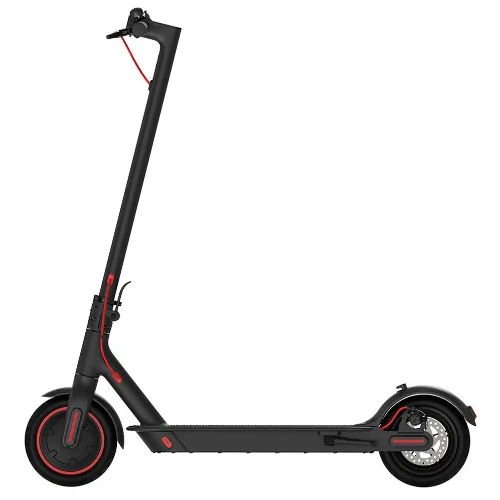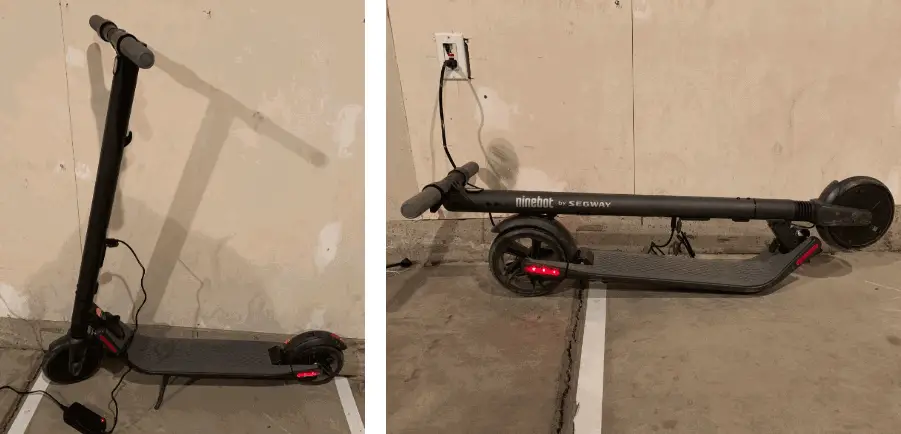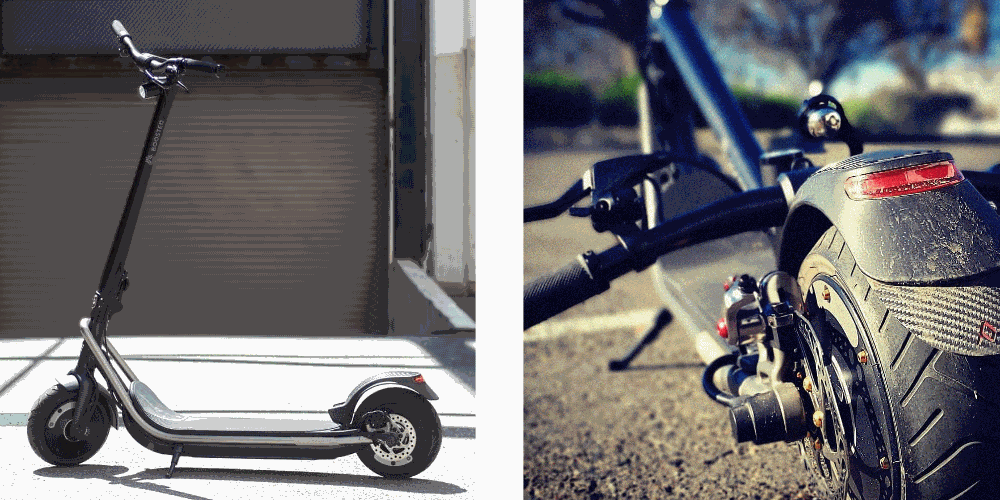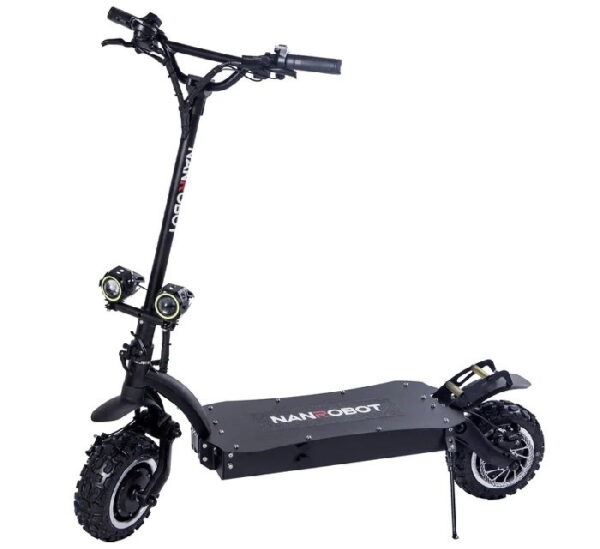Apollo City Review
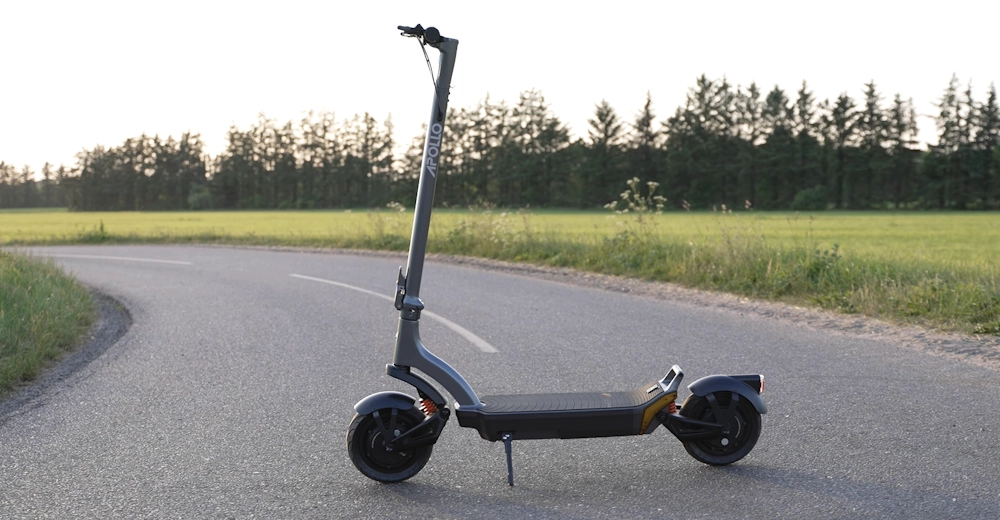

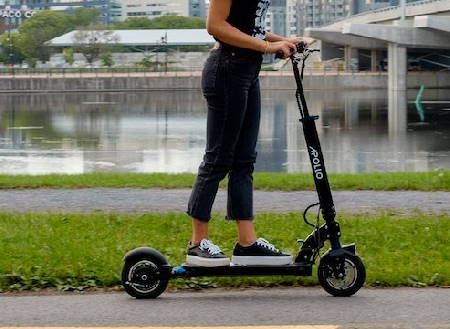
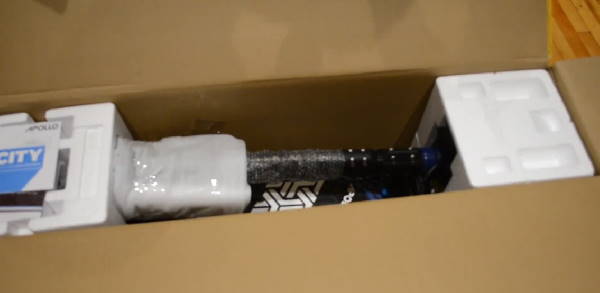
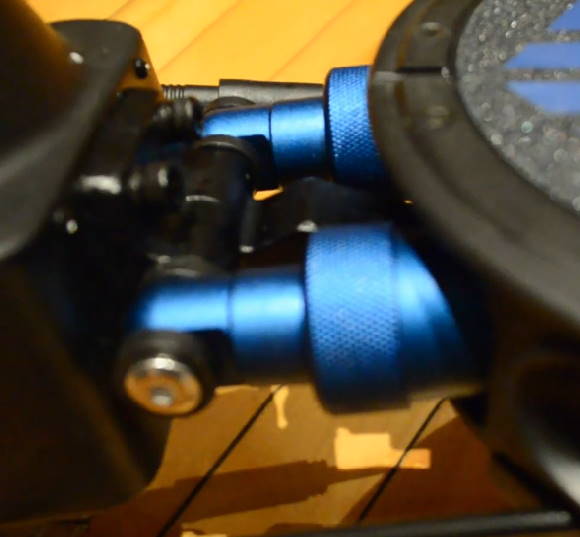

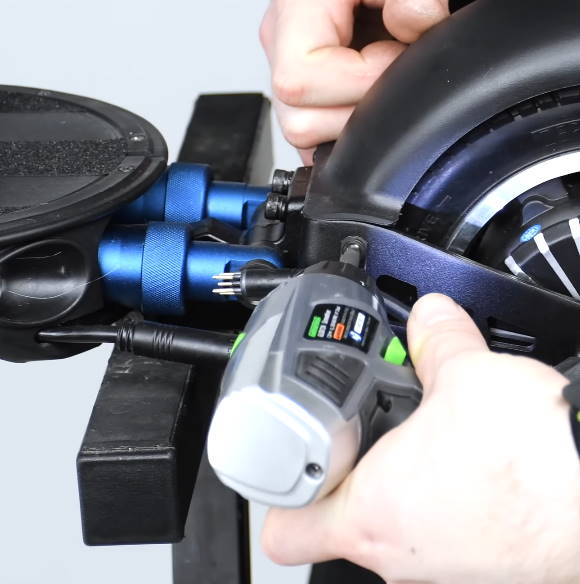
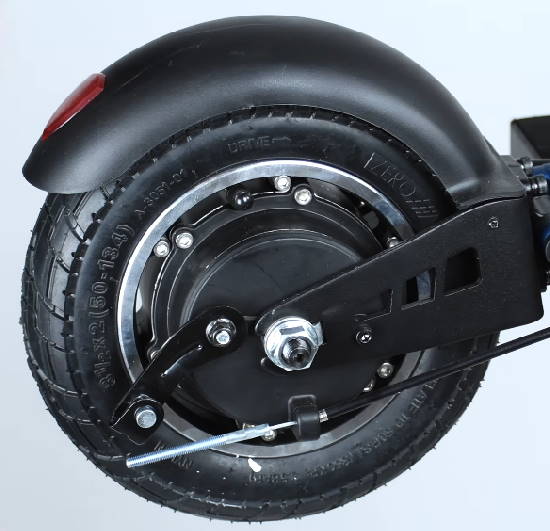

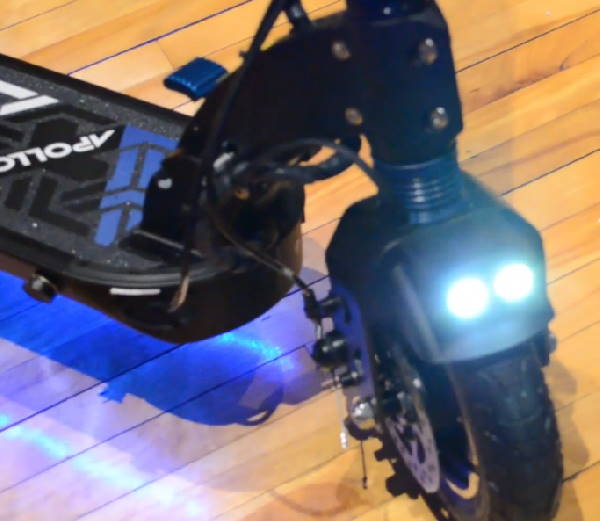

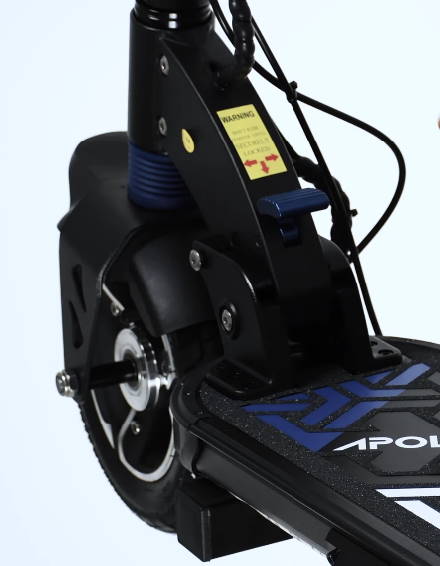


Apollo City Specifications
- Top speed: 40 kmh 25 mph
- Range: 45 km 28 mph
- Motors: rear hub BLDC
- Power: 600 W real, 800 W peak
- Climb angle: 15 °
- Battery: 634 Wh, 48 V
- Battery type: Dynavolt smart BMS
- Charging time: 8 h
- Avg. charging cost: US: $0.1, Canada: $0.06, UK: £0.2, EU: €0.19
- Ingress protection (IP): IP54
- Weight: 17.7 kg 39 lbs
- Weight limit: 120 kg 265 lbs
- Tire size: 8.5 in
- Tire type: pneumatic
- Tire pressure: 50 psi
- Foldable: yes
- Foldable handlebars: yes
- Build material: forged aluminium
- Terrains: streets, bike lanes, sidewalks, trails
- Brakes: rear drum + front disc + electronic
- Shock absorbers: front spring + rear dual spring
- Lights: two headlights + front LED strip + deck LED strips + rear brake
- Control: Apollo LED screen
- Speed modes: 3
- Cruise control: yes
- App: no
- Warranty: 12 months
- Rider age: 18-60
- Folded dimensions (L * W * H): 105 * 19.5 * 35.4 cm 41.34 * 7.68 * 13.94 in
- Adjustable handlebar: yes
Tests and measurements
- Speed tests (EScooterNerds): 40 kmh 25 mph
- Speed tests (third party): 39/40 kmh 24/25 mph
- Range tests (EScooterNerds): 42 km 26 mi
- Range tests (third party): 45 km 28 mi
- Climb tests (EScooterNerds): 15
- Climb tests (third party): 15
- Weight limit tests (EScooterNerds): 90 kg 198 lbs
- Weight limit tests (third party): 100/110 kg 220/243 lbs
- Waterproofing tests (EScooterNerds): no issues in rain or snow
- Waterproofing tests (third party): no issues in light rain
Ratings and scores
Pros
- very good quality
- great value for money
- great balance of features and performance
- great brakes
- good suspension
Cons
- grip tape on the deck might peel off
- flats are possible (not too common)
- might be slow for some (although it’s not supposed to be a fast scooter)
When to buy
The Apollo Explore electric scooter is ideal for individuals seeking a serious, high-quality model with balanced specifications and durability. It caters to those who don’t require excessive power for racing or off-road use and prefer a scooter with a strong focus on overall build quality, particularly in the battery department.
When not to buy
People on a tight budget, those living in areas with poor road conditions, individuals exceeding the weight limit, those needing a super-portable scooter, or those seeking a more water-resistant model should consider other options.
In this detailed Apollo Explore review, we will examine the rise to fame of this excellent scooter, and see exactly why it is one of the best mid-price choices in the world right now.
Basics
The Apollo Explore comes with a control system that’s robust and well-designed, yet fairly standard and easy to understand.
How to use
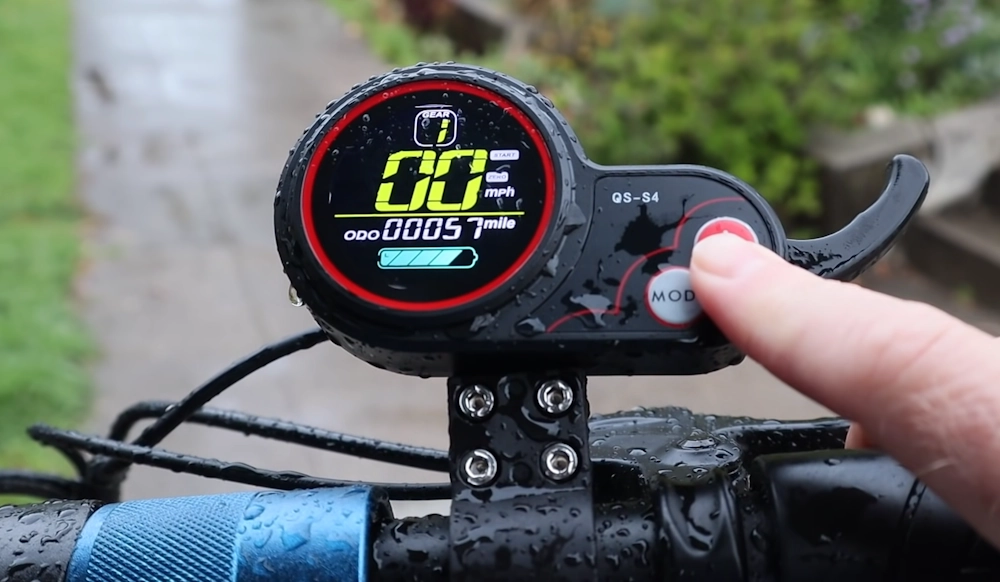
To turn the scooter on or off, you simply need to hold the power button down for 3 seconds. Keep in mind that the scooter will automatically turn off if not used for 90 seconds.
When the scooter is turned on, pressing the power button once toggles the screen display between the odometer or the trip distance.
Pressing the Mode button switches the speed mode, and holding it for 3 seconds toggles the lights on and off.
The display of the scooter will show you:
- current speed
- battery level
- battery voltage
- odometer or trip distance
- light status
The Apollo Explore comes with a trigger throttle acceleration mechanism. Personally, I prefer the thumb throttle mechanism, and recommend people get the after-market part from Apollo if they want to reduce finger fatigue.
The latest versions of the scooter come with a bell (previous versions didn’t).
Folding and unfolding
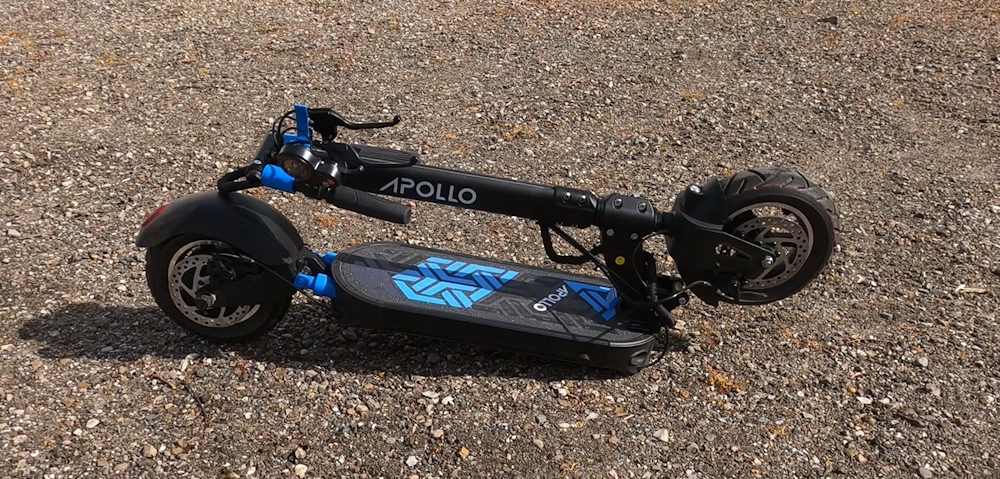
To unfold the scooter, press on the folding latch and pull the handlebars up until the safety pin is locked into the socket. This is best done by having one of your feet on the deck and pushing the handlebars up and forward until you lock the scooter in the unfolded position. Typically, you will hear a clicking sound when the safety pin locks in place, and you will know you’ve unfolded your scooter properly.
To fold the scooter, you will need to press down on the folding latch (usually with your foot), so that the folding mechanism is unlocked and you can fold the stem. You might find that the latch is almost stuck, which is an excellent safety feature, but in that case you will need to gently but firmly push the handlebars even more forward before you can press the latch down and fold your scooter. When you fold the scooter, you will again hear a clicking sound.
The handlebars of the Apollo Explore can also be folded to reduce the width and volume of the scooter for storing it.
Unboxing and assembly
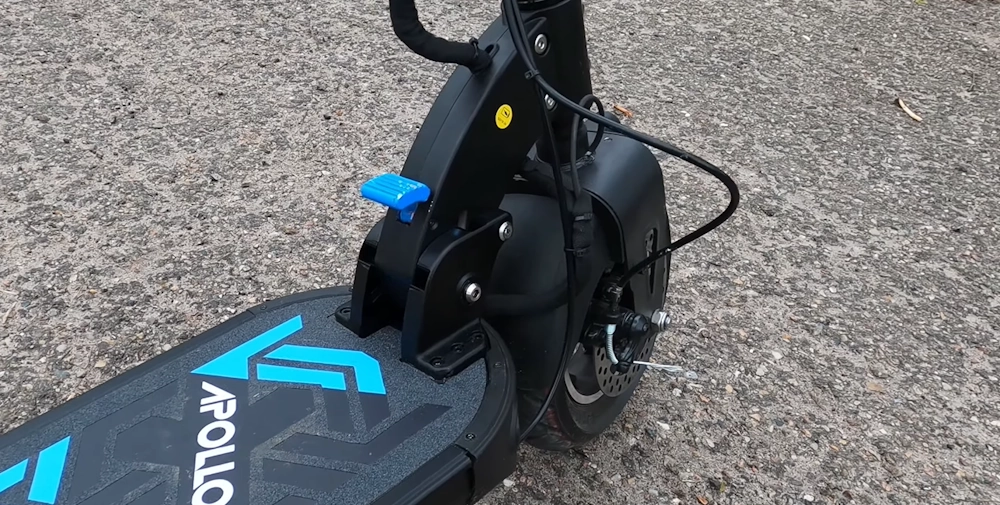
The scooter arrived almost fully assembled, and you will only need to remove the protective covers, set up the handlebar height, set the brake lever height to your desired level using the multikey tool, and then do a quick inspection to make sure everything is working properly.
I strongly recommend to fully charge your battery before using the scooter for the first time, as that will ensure you get the most lifespan out of it.
Also, make sure there are no loose screws and that both tires are sufficiently inflated before riding.
Performance
Let’s delve into a more comprehensive analysis of the performance provided by the Apollo Explore.
Motor and motor tests

The Apollo Explore has a single rear-drive hub BLDC motor with a real power level of 1000 Watts and a peak power of 1400 Watts.
Since this is a rear-drive scooter and not a front-drive one, the torque and the climbing abilities were slightly better as a result.
This motor is better than the motors of most scooters in this price category, and on par with the best motors in it as well.
Speed and speed tests
The official top speed of the Apollo Explore is 31 mph / 50 kmh.
During my test ride, the Apollo Explore achieved 29 mph / 47 kmh and it accelerates quickly, only needed 3.5 seconds to go from 0 to 15 mph / 25 kmh.
The scooter has 3 speed modes:
- 15.5 mph / 25 kmh
- 25 mph / 40 kmh
- 31 mph / 50 kmh
If you’re a speed enthusiast, this scooter won’t be fast enough for you, so take a look at some of the fastest electric scooters today.
Climbing angle and climb tests
The scooter can easily climb hills of up to 20° / 35.4%, which is also one of the best climb angles in this price category.
Even though this is an impressive climbing capability for a scooter, if you live in a hilly area and need an even higher climb angle for your scooter, check out my list for best electric scooters for climbing hills.
Range and range tests
Officially, the Apollo Explore has a range of 34 mi /55 km.
My test ride showed a maximum range of 31 mi / 49 km on a flat terrain.
However I must note that there was moderate wind during my ride, since this can be a crucial factor.
If you’re after a scooter with an even longer range, don’t worry, I got you – take a look at my list for best long-range electric scooters.
Battery and charging
The battery is one of the strongest features of the Apollo Explore, even though it doesn’t provide a ton of range.
Coming from Dynavolt, which is one of the best manufacturers of batteries for electric motorcycles, the lithium-ion battery will excel in quality and will provide you with steady performance for years and years to come.
In fact, the battery is likely to last you more than 2600 charge cycles, which is one of the longest lifespans you can find in the entire scooter world.
Some of the best battery features include:
- balanced internal cell charging and voltage protection
- overcharging protection, so you don’t have to worry about forgetting the scooter while charging
- temperature protection (although you should still be careful to not charge in environments too cold or too hot)
- over-current protection
- over-discharge protection
- short-circuit protection
The voltage of the battery is 52 Volts, and the capacity is 18 Amp-hours.
You should try and not drain your battery below 20% for optimal performance, and never drain it completely for the longest lifespan.
Charging the scooter fully takes around 9 hours. You should only charge your scooter with an original Apollo charger. The charger is located on the front right side of the deck, protected by a black rubber cap. As usual, the indicator light on the charger will light up in green when the charging is complete, and in red if the scooter is still charging.
Water resistance
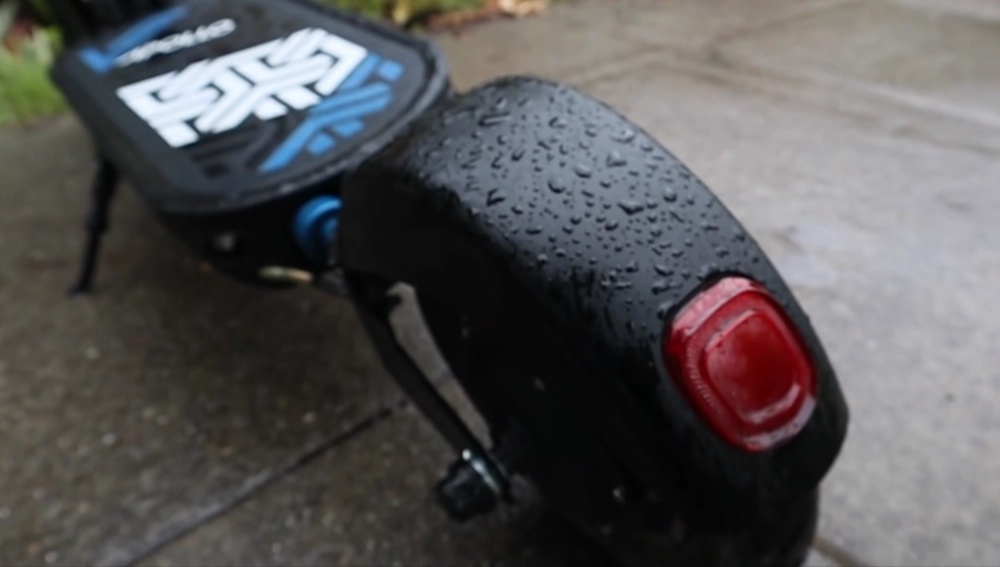
The official IP rating of the Apollo Explore is IP54. That means the scooter can handle water splashes from all angles and not suffer any damage.
Still, that doesn’t mean the scooter is entirely waterproof, even though a few users have reported riding the scooter through some rain without any issues whatsoever.
The scooter has a strong water resistance standard, but it is still recommended to avoid riding on any type of wet or slippery surfaces, including ice, snow, or unpaved roads.
However, if you live in a rainy area, just to be sure and protected, check out some other scooters with a higher IP ratings from my list for best waterproof electric scooters.
Ride experience

The scooter’s clever design provided ample deck space for my feet, ensuring stability through a robust folding mechanism and sturdy stem.
The large air-filled tires, combined with the dual suspension, contributed to an exceptionally smooth riding experience.
The Apollo Explore has quite wide handlebars, which gave me a lot of control, both for keeping the scooter steady when riding straight, and for fine-tuned turning and cornering.
The scooter boasts a well-balanced design attributed to its standard wheel width, dual suspension, sturdy build, substantial weight, low ground clearance, and an overall low center of gravity.
In my opinion, the likelihood of falling down from this scooter is extremely low.
Apollo Explore vs other electric scooters
The Explore’s swift rise to fame hasn’t been unchallenged, and several scooters have often been compared against it and have given scooterists some thought. Let’s see how the Apollo Explore fares in the most common comparisons.
Apollo Explore vs Apollo City 2022
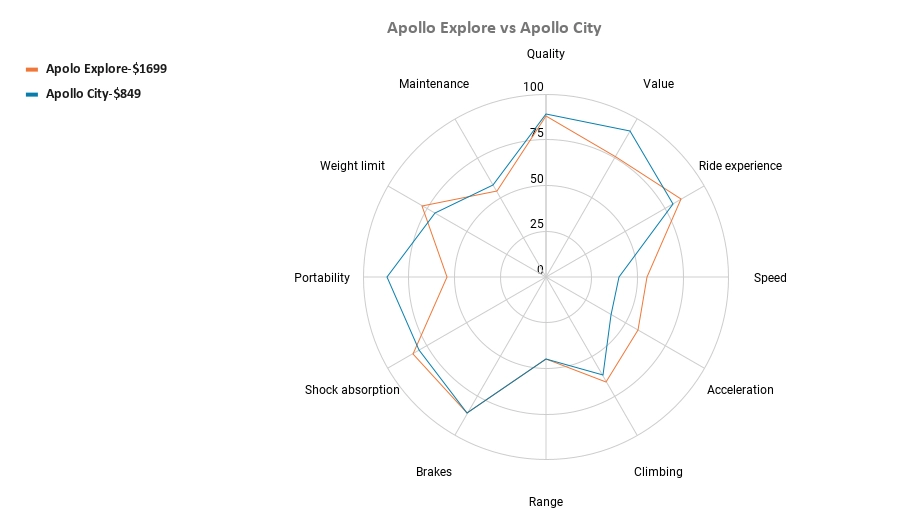
The Apollo City is the other Apollo scooter in their commuter line.
To be perfectly honest, I’m not exactly sure what’s the intent behind the Apollo City. It costs the same as the Apollo Explore, but it is slower, has less range, doesn’t climb as well, has less weight limit, all of that while weighing more. Its potential advantages might include better water protection and better suspension, but that’s about it.
In general, I wouldn’t recommend the Apollo City over the Apollo Explore. If you’re still curious about it, check out my Apollo City review.
Apollo Explore vs Apollo Ghost

There’s nothing quite like a bit of sibling rivalry, and the one between the Explore and the Ghost is probably the most pronounced inside of the Apollo scooter line.
However, while many enthusiasts love to compare these two scooters, I simply see the Ghost as an incremental upgrade of the Explore, similar to how the Xiaomi M365 Pro is an upgrade to the Xiaomi M365.
The Ghost will be around $200-$300 more expensive, depending on the type of brakes you choose, and the differences in performance and some additional features will reflect the price difference. It will come with a bit more range, a bit more speed, and a bit more climbing power.
Interestingly, the difference in motor power doesn’t seem to translate into concrete performance differences. The Ghost has two motors, and a peak power output of 2000 Watts, but it’s not that much more powerful than the Explore.
Naturally, both scooters will come with the same excellent level of quality.
The differences in acceleration and torque are the biggest advantages of the Ghost, which is not something that’s too important to many scooterists. I would recommend to most to stick with the Explore, and only go after the Ghost if you need a bit more juice out of your scooter.
You can find the Apollo Ghost on the official Apollo store.
Apollo Explore vs Apollo Phantom

The Apollo Phantom is on a completely different level than the Apollo Explore in pretty much every regard.
It is the bigger, stronger, faster sibling of the Explore, with more power, speed, range, climbing power, weight limit, and better brakes and suspension. It is also a lot more expensive, as might be expected.
Obviously, the Phantom will weigh more and be less portable as a result, so if you’re after an easily manageable commuter, you will want to stick with the Explore.
But if you’re after something completely different in terms of power and performance, and you have a budget of more than $2000 for it, then see my Apollo Phantom review.
Apollo Explore vs EMove Cruiser
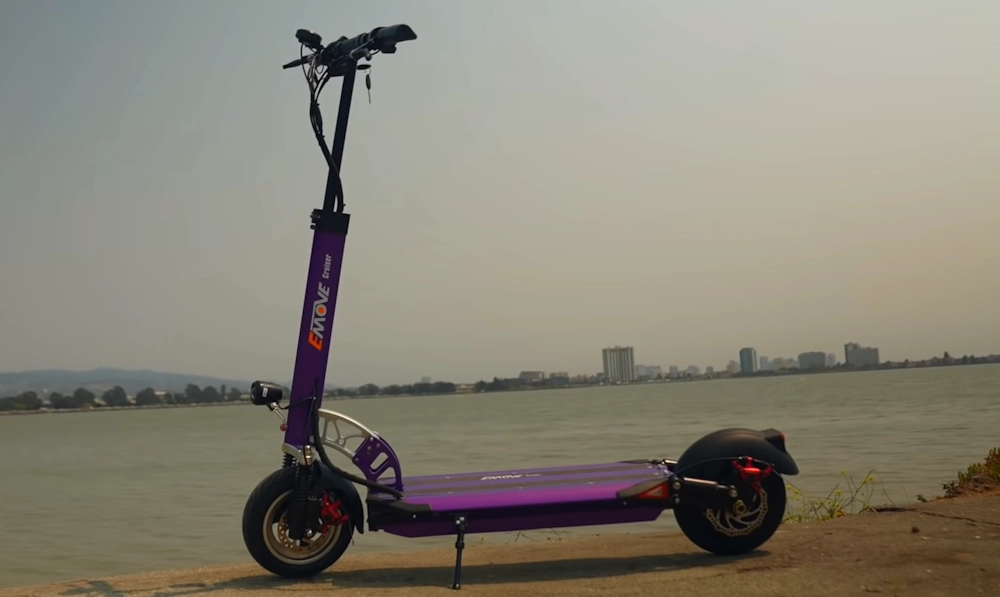
I believe the EMove Cruiser is the biggest rival to the Apollo Explore.
A few months ago, the Apollo Explore had a significant advantage in terms of price, and it was around $200 cheaper than the EMove Cruiser, but today, both scooters cost exactly the same, so that advantage is gone.
The Apollo Explore will perform a bit better, at least in terms of speed. It does have a higher real power level, although the peak power level is lower, but the real power level is more important, so we can say the Explore has a slightly better motor, which enables it to have a slightly higher top speed. The deck of the Explore will also be larger, and it will come with an extra braking system in the form of regenerative braking, which the Cruiser lacks.
The EMove Cruiser has a large range advantage, and with its massive range of 62 mi / 100 km, it has almost double the range of the Explore. Also, the world-famous IPX6 water protection standard of the EMove Cruiser is the best in the world right now, and that is exactly what many people are looking for.
In many other regards, both scooters are either similar or identical – excellent build quality, solid suspension, large 10-inch pneumatic tires, same weight, comparable dimensions. Ultimately, the choice is yours, and if the properties and specs of the EMove Cruiser sound more like what you’re after, then check out my complete EMove Cruiser review.
Apollo Explore vs Ninebot Max
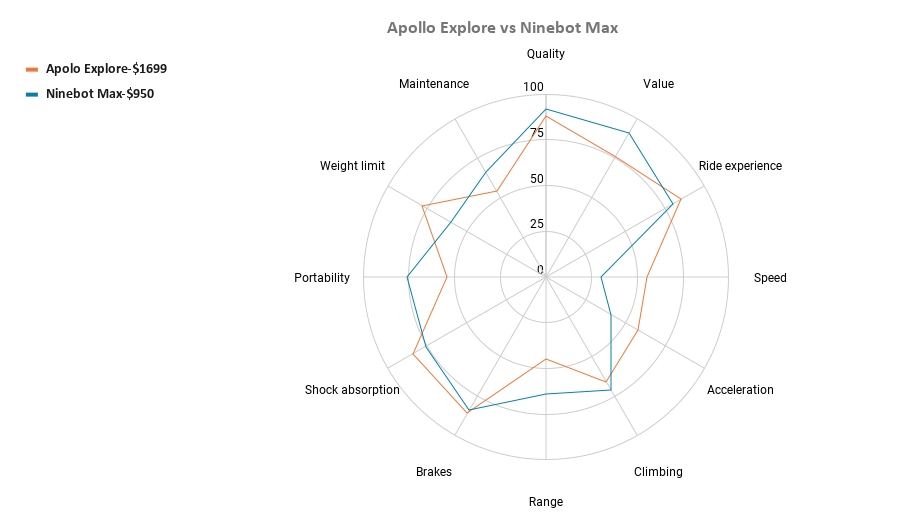
I’ve seen the Apollo Explore and the Ninebot Max pitted against each other several times, although I don’t think this comparison makes a lot of sense. The price difference between these two scooters is simply too great.
Not saying that the Ninebot Max is not a great scooter, because it is (probably the best scooter under $1000 right now), but when compared against the Apollo Explore, it falls short in most categories.
The better range and the slightly better water protection are all the advantages the Ninebot Max has. I recommend the Ninebot Max if those are the primary qualities you are after, and also if your budget is around $800, but in every other case, the Apollo Explore is simply better.
See my detailed Ninebot Max review if you’re interested in a cheaper scooter that’s still excellent.
Apollo Explore vs Zero 9
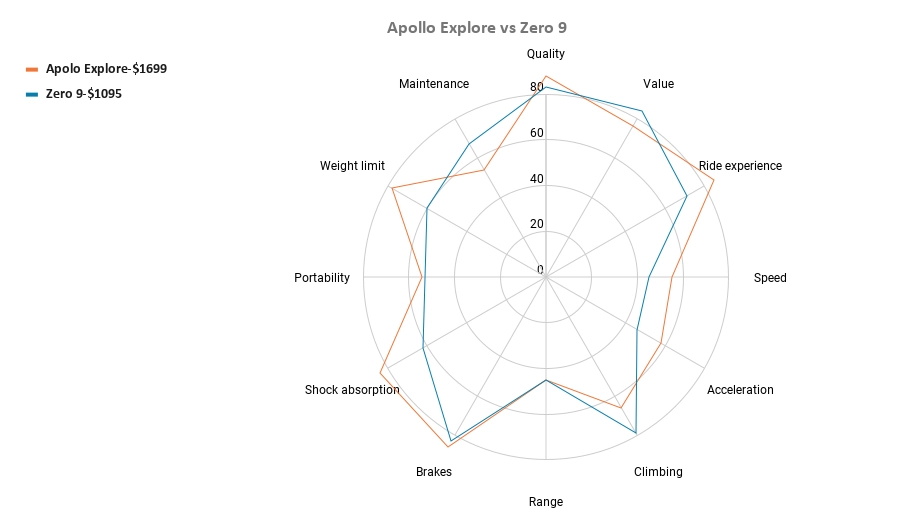
This is a fair comparison between two great mid-priced scooters.
The Zero 9 will be about $200 cheaper, but it will also be slower, have less range, less weight limit, and smaller tires that will result in shakier rides. The brakes and the suspension will also be better with the Apollo Explore.
The Zero 9 will obviously be lighter in weight and more portable. It’s a pretty solid scooter overall, it’s just a level below the Apollo Explore.
Apollo Explore vs Zero 10
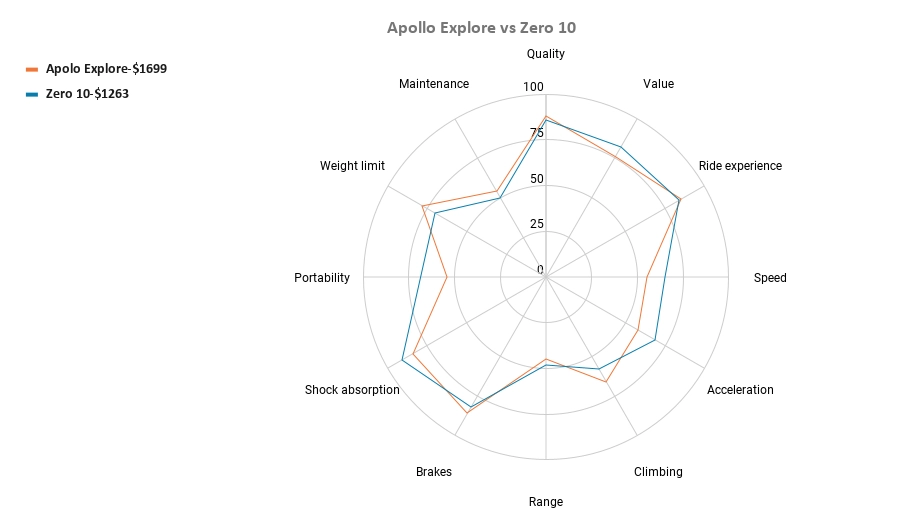
This is a classic speed-vs-range comparison, with the Apollo Explore being more capable of going the distance, while the Zero 10 being the better sprinter and having a higher top speed.
On paper, the Zero 10 should climb better, but there have been some doubts about the advertised high climb angle, and given how the motor configurations of both scooters are similar, I’d estimate the climbing power to be close to a tie.
Besides the range, the Apollo Explore has the IP rating which the Zero 10 lacks, and that may be the deciding factor for many, since both scooters cost the same, weigh the same, have very similar brakes and suspension, have the same dimensions somehow, and even cost the same.
The only clear use case for the Zero 10 is speed over range.
Apollo Explore vs Kaabo Mantis 8 Pro
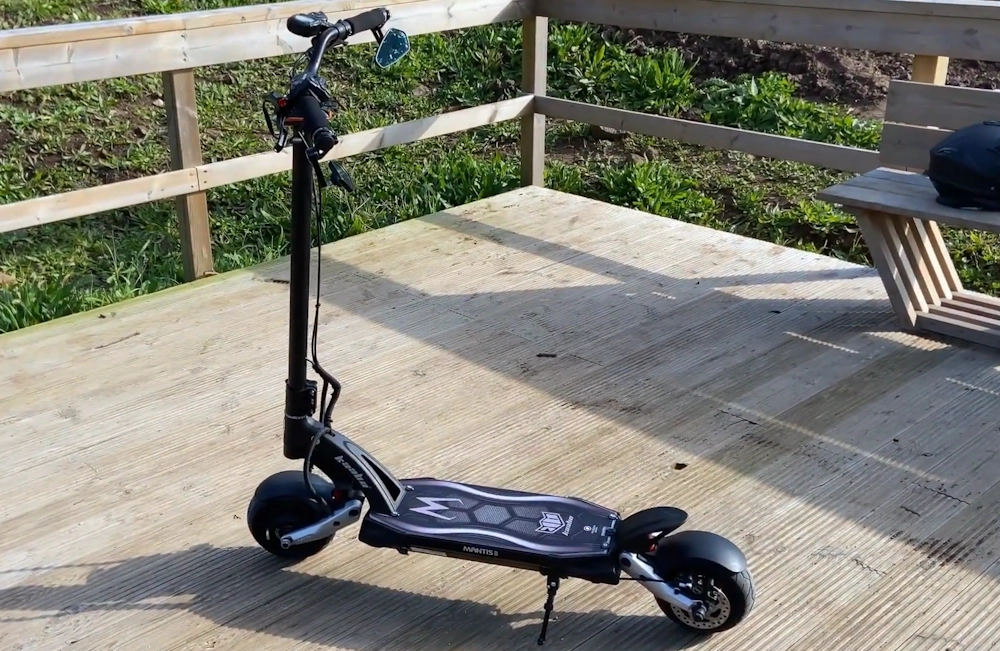
I’ve often seen these two scooters compared, although, in my opinion, it’s not exactly a fair comparison, since the Kaabo Mantis 8 Pro will cost about $600-$700 more.
And still, the Apollo Explore offers comparable performance, with only slightly smaller top speed and range, while the weight limit is the same, and the climbing power, the water protection, and the tire size and quality are even better with the Apollo.
The Kaabo Mantis 8 Pro will have better brakes (hydraulic ones), but that will be its main advantage, and, in my opinion, it’s simply not enough to justify the price difference. If you’re still curious about this scooter for any reason, you can check it out at FluidFreeRide.
Apollo Explore vs Varla Pegasus
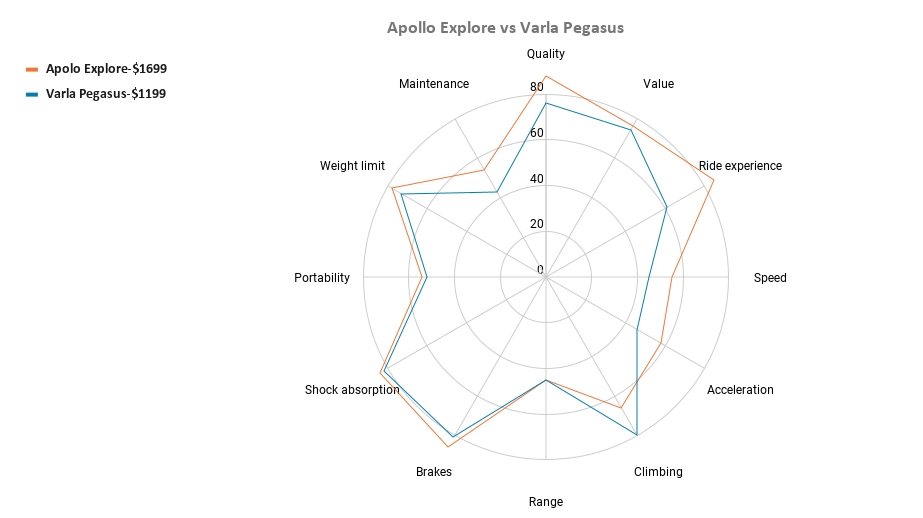
Varla is a relative newcomer to the scooter scene, but they have been making some splashes, and some of their models seem to be major hits.
The Varla Pegasus is the closest to the Apollo Explore in terms of price and performance. It is only about $100 cheaper, but it is also about 3 mph / 5 kmh slower and has about 6 mi / 10 km less range, which is not a very good tradeoff in my opinion. Other advantages of the Apollo Explore include better water protection and bigger tires.
Interestingly, the Varla Pegasus will climb better, will have a bigger weight limit, and may accelerate better, so if those advantages sound intriguing to you, you can check it out at the official Varla store.
Build quality
Build quality is arguably the biggest reason why Apollo scooters were able to make such a splash on the scooter scene. Since the Apollo Explore is their most popular scooter, it’s no wonder that the quality of this particular model is very, very good.
Made from forged aluminum, and only using high-quality parts, the scooter is tough, durable, and robust, without being too heavy.
The scooter has already been through several iterations, and the latest versions come with upgraded stems, stronger folding mechanisms, better fenders, a more rigid kickstand, and more reliable electronics.
Apollo scooters always undergo thorough rigorous quality control (3 rounds!) before being shipped to customers, and dead-on-arrival incidents, as well as major defects after little usage, are very uncommon.
Features
Let’s take a closer look at Apollo Explore’s features.
Brakes and suspension
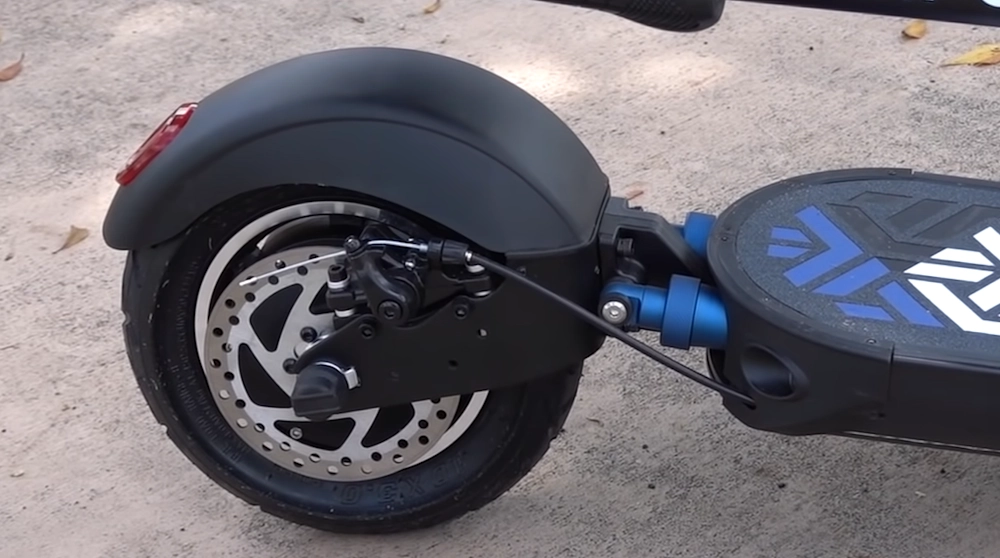
The brakes are a strong side of the Apollo Explore.
With dual disk brakes, one on each wheel, and an electronic regenerative brake to refill the battery, the Explore has one of the strongest brake setups in the mid-price scooter category.
Each of the disk brakes was activated by a lever on the handlebar (left for the rear brake, right for the front brake), and the electronic brake was activated whenever I used either one of them.
You can expect braking distances of just 8 ft / 2.5 m, even when stopping from higher speeds.
To make the rides even safer and more comfortable, the scooter comes with a solid suspension system as well, with dual spring suspension in the rear, and a spring suspension between the stem and the wheel in the front.
Now, the suspension was pretty good, but not the best one out there. It certainly gets the job done, but the large tires were by far a more important factor when it came to ride comfort.
Tires, wheels, and fenders

The Apollo Explore comes with large pneumatic rubber tires, 10 inches in diameter. The tires have inner tubes, which makes them a bit more vulnerable to flats, but also they provide the maximum ride comfort, and Apollo offers their own tire sealant solution that will reinforce the tires and make flats a lot less likely.
The tires have the standard shallow treads, and were perfect for any type of urban setting. Because of their large diameter, and the shock absorption system, the scooter was able to handle some off-road rides, although that’s not what the scooter is designed for.
The recommended tire pressure is 50 PSI.
The latest version of the Apollo Explore comes with stronger fenders as well, much more stable than the fenders found in the previous version.
If you’re after a scooter with specific tires, designed for off-road use, check out my list for best off-road electric scooters.
Lights
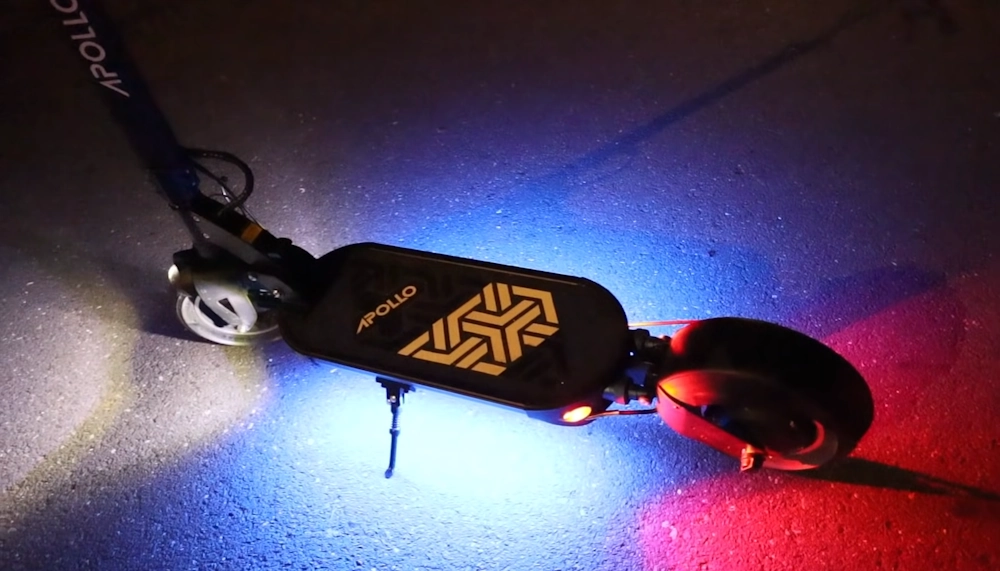
In the front, the Apollo Explore has two white LED lights situated in the deck.
In the rear, the scooter has two red LED lights that light up whenever you use the brakes.
Additionally, the scooter has blue LED strips along the deck and the stem that increase your visibility in traffic at night.
While the scooter has plenty of lights, the main headlights were not terribly bright, and they were placed on the deck so they didn’t really light up the road too far ahead.
So, you may want to check out some additional after-market lights if you plan on riding at night. The Apollo headlight has a brightness of 2500 Lumens, and will get the job done quite well.
Supported rider weight and height
The weight limit of the Apollo Explore is 265 lbs / 120 kg, which makes it a fairly good scooter for heavier adults.
Several reviews from owners close to the weight limit (and even above in some instances) confirm that the scooter has been able to support them without any noticeable drops in performance.
The handlebar height is adjustable, and the maximum distance between the deck and the handlebars is around 39 in / 99 cm, so the scooter will be suitable for riders close to average height.
And if you’re taller and need a higher stem and wider handlebars, check out my list for electric scooters for tall adults.
Portability, weight, and dimensions

The Apollo Explore weighs 52 lbs / 23.6 kg. That places it right in the middle of the portability spectrum – not exactly light, but far from heavy as well.
The dimensions of the scooter are:
- length: 46 in / 117 cm
- width: 7.7 in / 19.5 cm (folded)
- height: 48 in / 122 cm (unfolded), 17 in / 43.2 cm (folded)
With that kind of weight and dimensions, the Apollo Explore is a scooter of medium portability, possibly leaning slightly towards being a bit heavy for smaller people.
It still fit easily into the trunks of most cars, with the smallest trunks being the one possible exception.
However, if you’re often on the move you’ll need a more portable scooter so check out my list most portable electric scooters.
When folded, the scooter has a natural center of gravity close to the middle of the stem, and is not awkward to carry.
Deck and stem
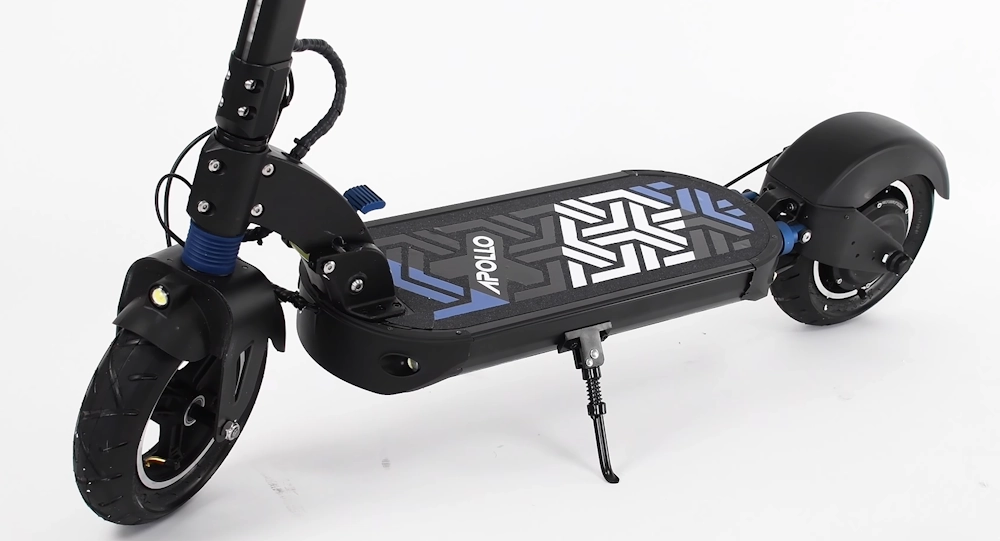
The deck is very spacious, with 20 in / 51 cm in length, and 9 in / 23 cm in width.
With a ground clearance of 5.5 in / 14 cm, the scooter’s deck is tall enough for riding over smaller curbs. The deck features a gripped surface on top of it that prevented slipping.
The kickstand is very thick and holds the scooter very steadily while leaning on it.
The stem of the scooter is very solid in particular, as it’s not just the plain old cylindrical pipe found in the budget models but a stronger triangle-shaped design, and has additionally reinforced aluminum and other metals to make it stronger.
Accessories and customizations
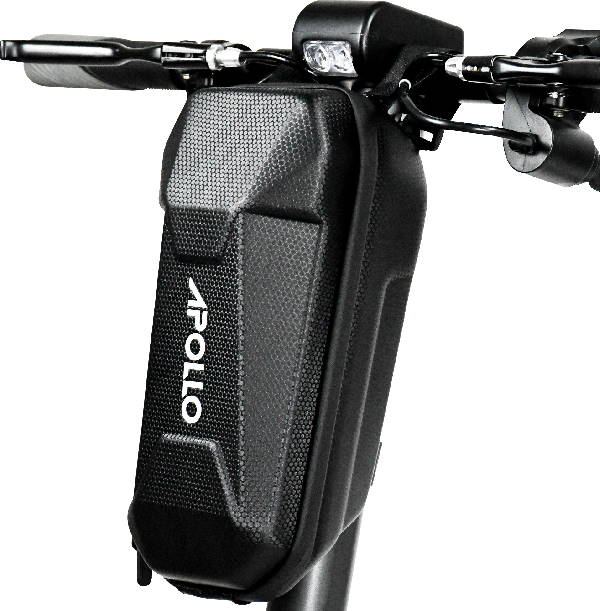
You can find a ton of accessories and customizations that will fit the Apollo Explore like a glove from the official Apollo store.
They have divided the products for their scooters into three categories:
I usually recommend getting at least the storage bag and the anti-theft alarm as the most useful accessories, and the super clamp as the best upgrade to reinforce the folding mechanism. Personally, I’m not very fond of trigger throttles, which is what the Explore has, so I recommend getting the Apollo thumb throttle upgrade as well, although that’s more a matter of personal preference.
While you probably won’t have to, you can also see my guide on the generic scooter accessories – you might still find a few interesting ideas there. Also, don’t forget to wear the proper scooter helmet at all times while riding the Apollo Explore, as it is capable of pretty high speeds and it’s risky to ride without a helmet, and injuries can be quite serious.
Security and locking
The Apollo Explore doesn’t come with any security features like a key ignition or an app to lock the motor.
Since it’s not exactly a cheap scooter, you will definitely want a strong scooter lock to prevent theft. You can take a look at the ETook folding lock from Apollo as well, it will fit the scooter perfectly. Also, check out the anti-theft alarm for added protection.
Maintenance and spare parts
The usual scooter cleaning and maintenance will be perfect for the Apollo Explore:
- use a soft damp cloth to clean the scooter, and use soap or toothpaste to remove stains (don’t use alcohol or other corrosive materials)
- make sure all the screws are tightly screwed
- make sure both tires are inflated and no air is leaking from them
The warranty will cover a lot of the spare parts, but even after the warranty period expires, you will still be able to get the parts for cheap.
App
Apollo scooters don’t have Bluetooth features and can’t connect to an app.
I recommend the Universal Scooter App by EScooterNerds as a partial solution. Of course, it will not be able to connect to the scooter neither, but it will provide you with other useful features such as calculators, resources, guides, discounts, tools, hacks, etc. You can find the app available on the Apple App Store and the Google Play Store.
Known issues and tradeoffs
Since quality is one of the main points of focus of the Apollo Explore, issues and problems with it are very rare.
In fact, this is probably one of the highest-quality mid-price scooters out there, defects are very rare, and there are only a few known issues downsides you should be aware of.
Probably the most commonly reported quality issue has been the front wheel getting crooked and out of line with the handlebars. And this issue has only been reported a handful of times.
Previous versions of the scooter did have a problem with the fenders been too shaky and even breaking apart, but the newest version has successfully addressed that problem, and that’s now a thing of the past.
One issue that’s still present is the instability of the handles. This is always the case for scooters that come with foldable handlebars, and in my opinion it is a worthy tradeoff considering the increased portability you get in return, but it is still an issue you should be aware of. Only a handful of users have reported true handlebar wobbliness, and the stem and the handlebars overall are very stable.
My personal pet peeve with this scooter is the position of the front lights. Deck lights simply don’t cast the light far enough unless they are extremely strong, which is not the case with the lights of the Explore. If you plan to ride at night, I recommend getting stronger after-market lights that you will mount on the top of the handlebars.
Finally, another pet peeve of mine is the trigger throttle. I prefer thumb throttles, although this is highly subjective, so it’s not really a problem of the Apollo Explore. Also, you can get the Apollo thumb throttle as an after-market upgrade, which completely eliminates this issue.
Verdict
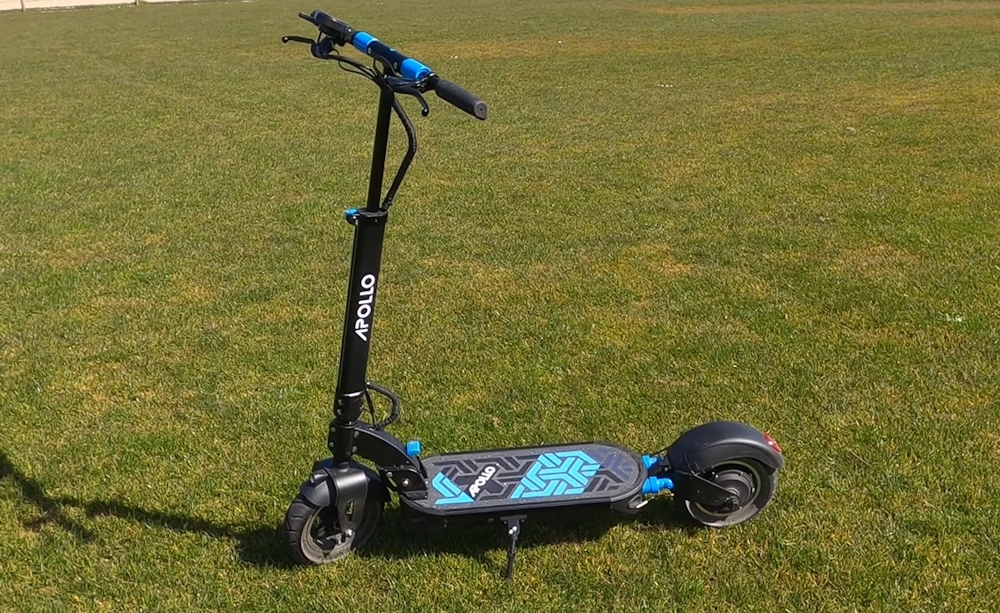
The Apollo Explore is one of the best electric scooters I’ve tried, and certainly one of the best choices for under $2000.
It comes from a very reputable and growing brand, its primary focus is quality and positive owner experience overall, without lagging in performance, and it can satisfy many different categories of scooterists.
This will not be a crazy powerful scooter, and probably not the most portable lightweight model out there. But for anything in between, the Apollo Explore is definitely a perfect pick.
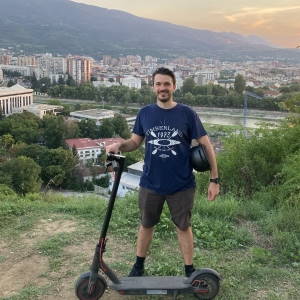
Worldwide: Apollo (use coupon code NE28PN5KFW for extra $50 worth of free accessories)
Worldwide: FluidFreeRide
UK, Europe: Ride And Glide

